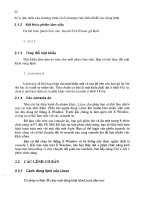Bài giảng Nhập môn Hệ điều hành: File system (Hard Link - Soft Link) - Nguyễn Xuân Vinh
Bạn đang xem bản rút gọn của tài liệu. Xem và tải ngay bản đầy đủ của tài liệu tại đây (143.38 KB, 13 trang )
GV: NGUYỄN XUÂN VINH
NHẬP MÔN HỆ ĐIỀU HÀNH
INTRODUCTION TO OPERATING SYSTEMS
NHẬP MÔN HỆ ĐIỀU HÀNH
[214242]
FILE SYSTEM
Hard Link - Soft Link
Nguyễn Xuân Vinh
1
/XX
5/8/21
GV: NGUYỄN XUÂN VINH
NHẬP MÔN HỆ ĐIỀU HÀNH
5/8/21
/XX
2
File Parts
Unix files consist of two parts:
Data part: associated with Inode which carries the map of where the data is, the file permissions, …
Filename part : carries a name and an associated inode number.
More than one filename can reference the same inode number
These files are said to be “hard linked” together
NHẬP MÔN HỆ ĐIỀU HÀNH
GV: NGUYỄN XUÂN VINH
Hardlinked
3
/XX
5/8/21
The specific location of physical data.
GV: NGUYỄN XUÂN VINH
Soft link (symbolic link, symlink)
Special file type whose data part carries a path to another file
OS recognizes the data as a path, and redirects opens, reads, and writes so that, instead of accessing the data within
4
/XX
5/8/21
NHẬP MÔN HỆ ĐIỀU HÀNH
the special file
A symbolic path indicating the abstract location of
another file.
GV: NGUYỄN XUÂN VINH
Directory
The directory, as a file, is just an array of filename parts of other files
When a directory is built, it is initially populated with the filename parts of two special files: the “.” and “..” files.
The filename part for the “.” file is populated with the inode# of the directory file in which the entry has been
made.
5
/XX
5/8/21
NHẬP MÔN HỆ ĐIỀU HÀNH
“.” is a hardlink to the file of the current directory.
The filename part for the “..” file is populated with the inode# of the directory file that contains the filename part
of the current directory file.
“..” is a hardlink to the file that implements the immediate parent of the current directory.
GV: NGUYỄN XUÂN VINH
NHẬP MÔN HỆ ĐIỀU HÀNH
5/8/21
/XX
6
Restrictions
Hardlinked:
Both links must reside on the same filesystem.
The source file must exist.
Hard links shouldn’t link directories.
Softlinks:
Source and target can be on separate file systems.
Source does not have to exist.
Additional I/O necessary to complete file access
Additional storage taken up by softlink file’s data
GV: NGUYỄN XUÂN VINH
Let's start off with an empty directory, and create a file in it
Now, let's make a hardlink to the file
7
/XX
5/8/21
NHẬP MÔN HỆ ĐIỀU HÀNH
Example
a.hardlink.file shares the same inode (73478) as basic.file
b.hardlink.file shares the same data as basic.file
GV: NGUYỄN XUÂN VINH
Example
If we change the permissions on basic.file:
NHẬP MÔN HỆ ĐIỀU HÀNH
then the same permissions change on hardlink.file.
Let's now make a softlink to the original file:
8
/XX
5/8/21
Here, we see that although softlink.file accesses the same data as basic.file and hardlink.file, it does not share the same inode
(73479 vs 73478), nor does it exhibit the same file permissions. It does show a new permission bit: the 'l' (softlink) bit
GV: NGUYỄN XUÂN VINH
File System
If we delete basic.file:
NHẬP MÔN HỆ ĐIỀU HÀNH
then we lose the ability to access the linked data through the softlink:
However, we still have access to the original data through the hardlink:
You will notice that when we deleted the original file, the hardlink didn't vanish. Similarly, if we had deleted the softlink, the original file wouldn't have
9
/XX
5/8/21
vanished.
GV: NGUYỄN XUÂN VINH
NHẬP MÔN HỆ ĐIỀU HÀNH
5/8/21
/XX
10
File System
When deleting files, the data part isn't disposed of until all the filename parts have been deleted
There's a count in the inode that indicates how many filenames point to this file
That count is decremented by 1 each time one of those filenames is deleted
When the count makes it to zero, the inode and its associated data are deleted
By the way, the count also reflects how many times the file has been opened without being closed (in other
words, how many references to the file are still active)
Can delete a file so that no "filename" part points to the inode, without releasing the space for the data part of the
file, because the file is still open
GV: NGUYỄN XUÂN VINH
/var/log/messages
notice that /var/log/messages (or some other syslog-owned file) has grown too big, and you
NHẬP MÔN HỆ ĐIỀU HÀNH
to reclaim the space, but the used space doesn't reappear? This is because, although you've deleted the filename part,
there's a process that's got the data part open still (syslogd), and the OS won't release the space for the data until the
process closes it. In order to complete your space reclamation, you have to
11
/XX
5/8/21
to get syslogd to close and reopen the file.
GV: NGUYỄN XUÂN VINH
NHẬP MÔN HỆ ĐIỀU HÀNH
5/8/21
/XX
12
Advantage in programs
use this to your advantage in programs: have you ever wondered how you could hide a temporary file? Well, you
could do the following:
13
/XX
5/8/21
NHẬP MÔN HỆ ĐIỀU HÀNH
GV: NGUYỄN XUÂN VINH
HỎI ĐÁP









